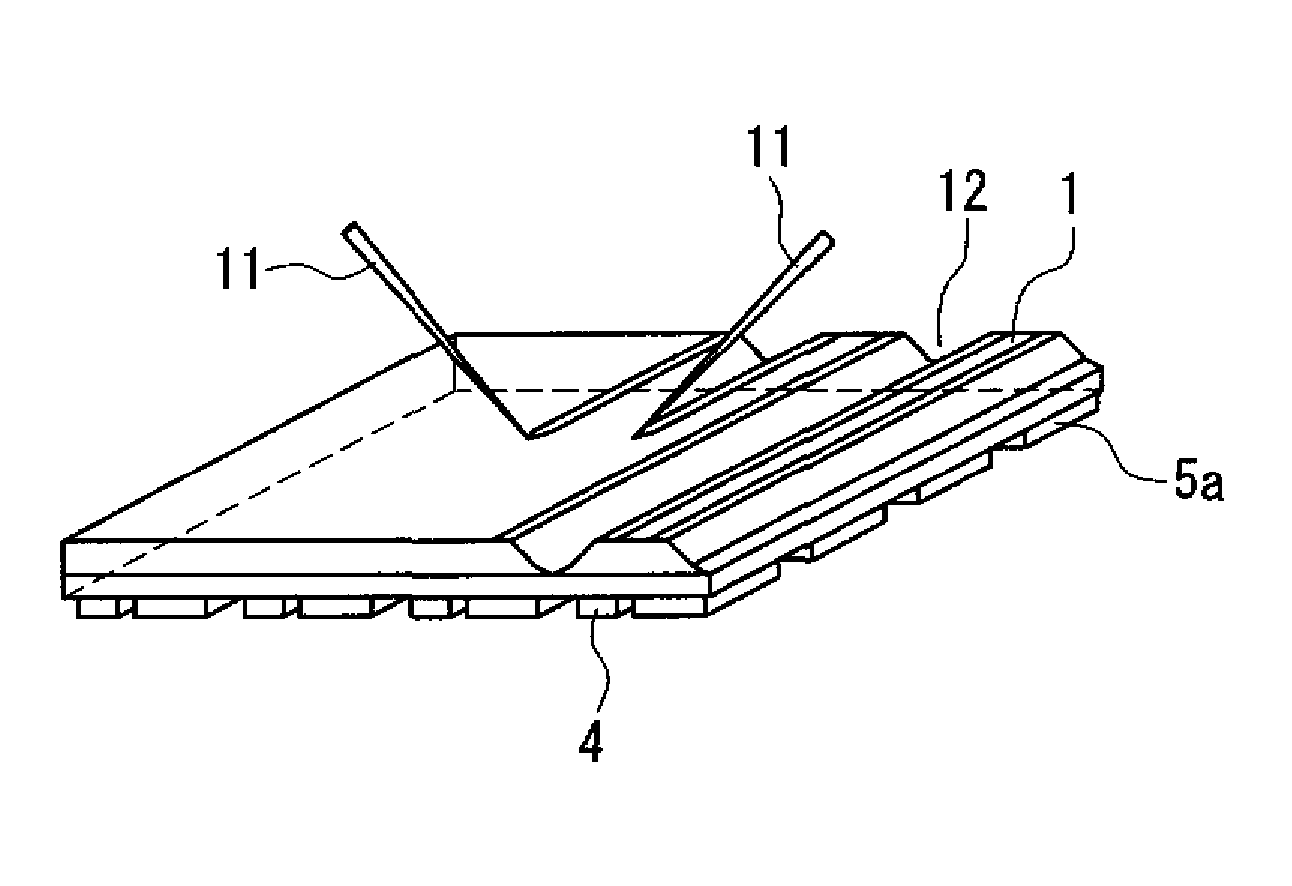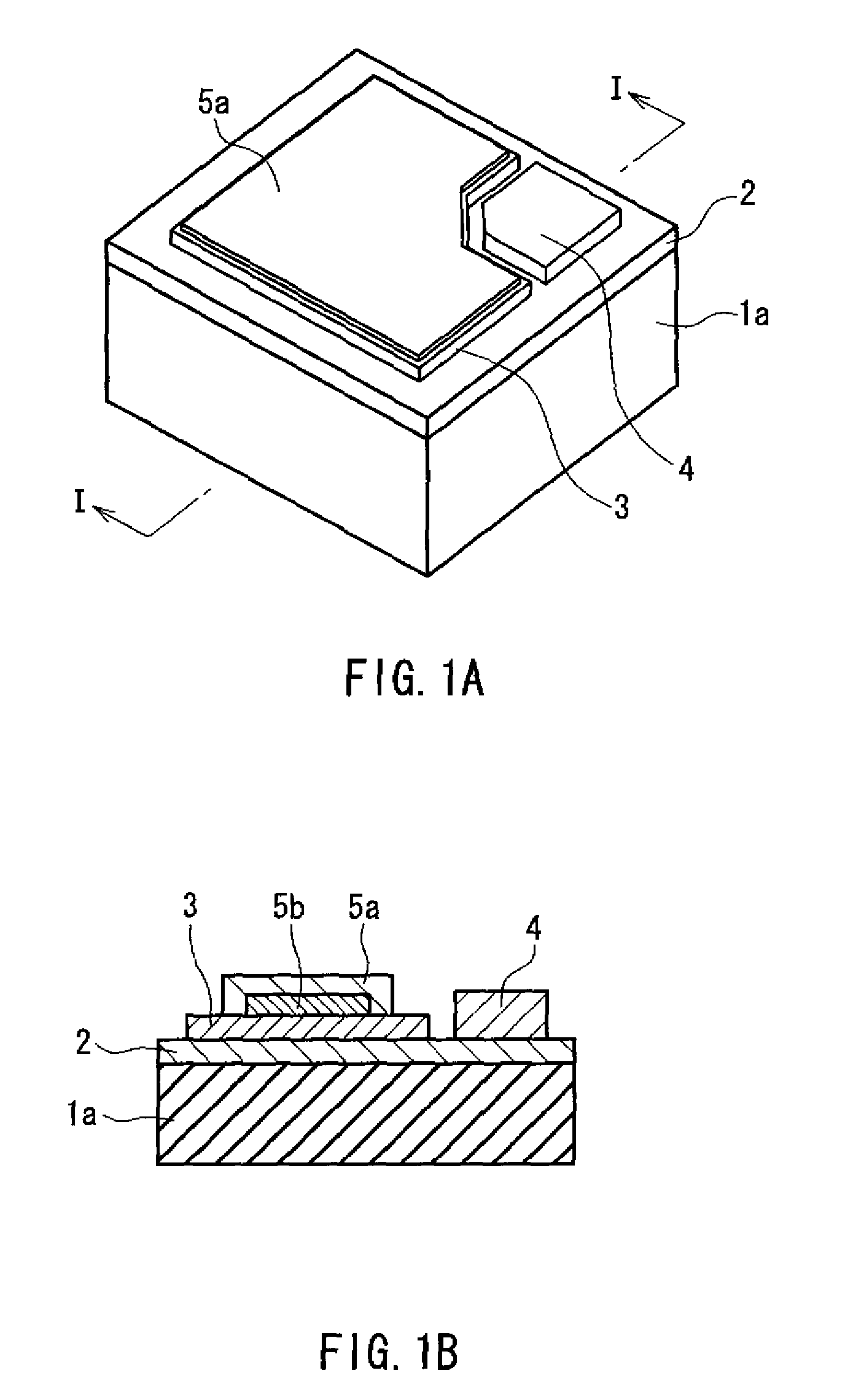Semiconductor device
a semiconductor device and semiconductor technology, applied in the field of semiconductor device manufacturing, can solve the problems of high cost, high frequency of replacement and high cost, and the hardness of the substrate is not very high, and achieve the effect of low incidence of electrode continuity failure and resin peeling
- Summary
- Abstract
- Description
- Claims
- Application Information
AI Technical Summary
Benefits of technology
Problems solved by technology
Method used
Image
Examples
embodiment 1
[0040]Explanations regarding a light-emitting element, as an example of the semiconductor devices obtained by the semiconductor device manufacturing method used in Embodiment 1 of the present invention, will be provided with reference to FIGS. 1A-B and FIGS. 2A-F. FIGS. 1A-B illustrate the configuration of a semiconductor device obtained using the semiconductor device manufacturing method used in the embodiments of the present invention. FIGS. 2A-F illustrate a semiconductor device manufacturing method used in an embodiment of the present invention.
[0041]First of all, explanations will be provided based on FIGS. 1A-B regarding the configuration of a light-emitting element, as an example of the semiconductor devices obtained using the semiconductor device manufacturing method used in the embodiments of the present invention.
[0042]As shown in FIGS. 1A-B, in an individual light-emitting element produced by dicing (length: 350 μm, width: 350 μm, height: 100 μm), an n-type semiconductor ...
embodiment 2
[0061]In the method for manufacturing a semiconductor device used in Embodiment 2 of the present invention, as shown in FIG. 2D, an n-type semiconductor layer 2 and a p-type semiconductor layer 3 are formed on a substrate 1 and grooves are formed by irradiating the face on which the n-type electrode 4 and p-type electrode 5a are formed with YAG laser light 6. However, irradiation with YAG laser light 6 also can be performed on the side opposite the side on which the n-type semiconductor layer 2 and p-type semiconductor layer 3 are formed.
[0062]As shown in FIG. 3A, the grooves 10 were formed by irradiation with the YAG laser light 6 on the side opposite the side where the n-type electrode 4 and p-type electrode 5a were formed. Thus, forming the grooves 10 on the face of the substrate 1 that was opposite the face on which the electrodes were formed made it possible to form the grooves 10 without subjecting the interface between the n-type electrode 4 and p-type electrode 5a and the n-...
embodiment 3
[0067]Next, the method for manufacturing a semiconductor device used in Embodiment 3 of the present invention is explained with reference to FIGS. 4A-H.
[0068]FIGS. 4A-C represent the same steps as FIGS. 2A-C, and therefore the corresponding explanations are omitted. In the steps depicted in FIGS. 4A-C, semiconductor layers and electrodes were formed on a sapphire or gallium nitride substrate, and, in order to separate the substrate 1, which had a predetermined thickness, into individual light-emitting elements, the face of the substrate that was opposite the face on which the p-type electrode 5a and n-type electrode 4 had been formed, was adhered to a dicing tape 13 made of polyethylene etc. (FIG. 4D)
[0069]The face of the substrate 1 on which the p-type electrode 5a and n-type electrode 4 had been formed was irradiated along vertical and horizontal transects with YAG laser light 6 to form boundary grooves with a depth of at least 30% of the thickness of the substrate 1 (FIG. 4).
[007...
PUM
| Property | Measurement | Unit |
|---|---|---|
| temperature | aaaaa | aaaaa |
| depth | aaaaa | aaaaa |
| height | aaaaa | aaaaa |
Abstract
Description
Claims
Application Information
 Login to View More
Login to View More - R&D
- Intellectual Property
- Life Sciences
- Materials
- Tech Scout
- Unparalleled Data Quality
- Higher Quality Content
- 60% Fewer Hallucinations
Browse by: Latest US Patents, China's latest patents, Technical Efficacy Thesaurus, Application Domain, Technology Topic, Popular Technical Reports.
© 2025 PatSnap. All rights reserved.Legal|Privacy policy|Modern Slavery Act Transparency Statement|Sitemap|About US| Contact US: help@patsnap.com



